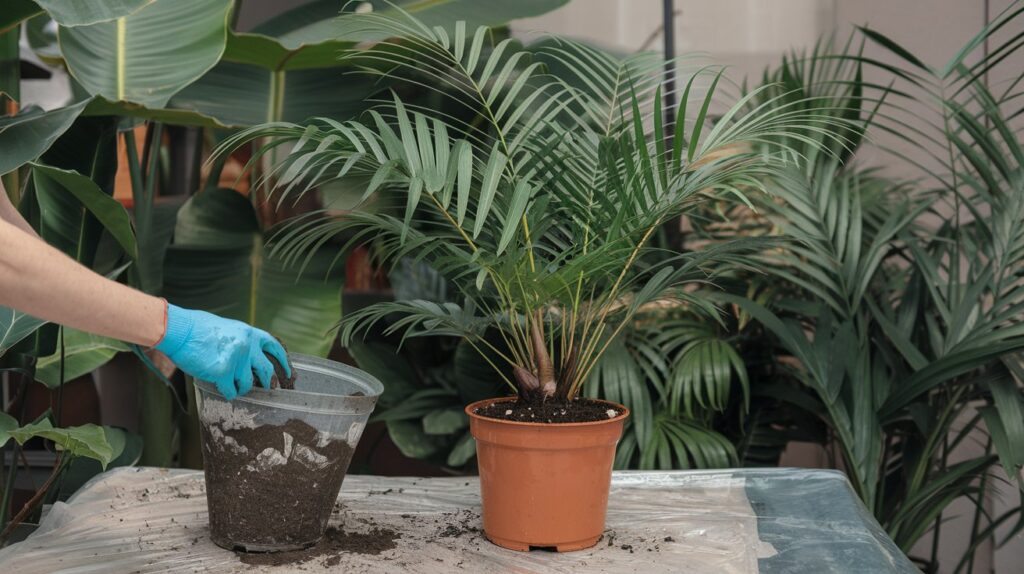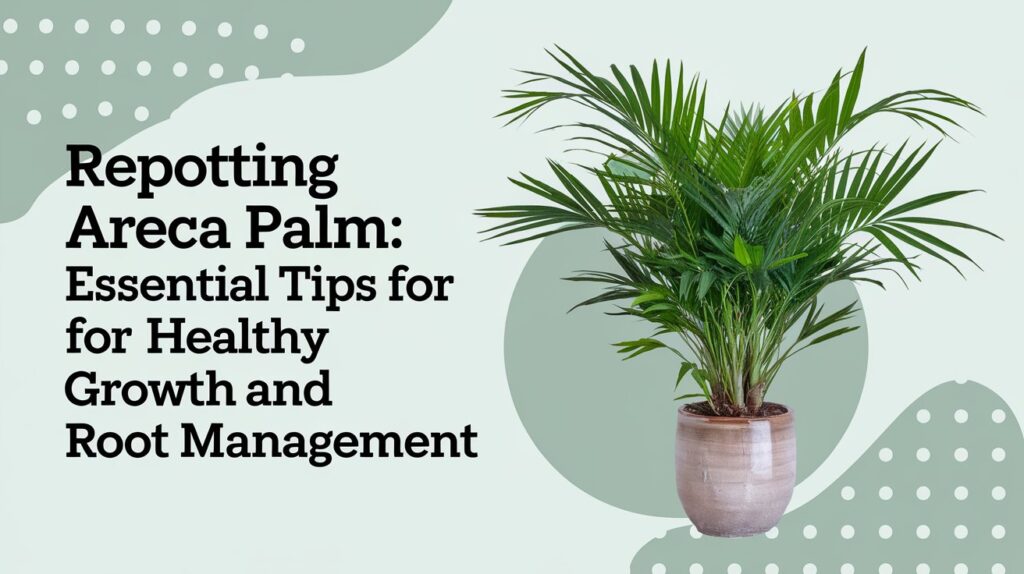Areca palms are truly one of the most beautiful additions to any home, but like all plants, they require the right care to thrive. One of the most important aspects of maintaining a healthy Areca palm is knowing when and how to repot it. Trust me, I’ve been through this process myself, and it can make a world of difference in how your plant grows.
In this guide, I’m sharing everything you need to know about repotting areca palm, managing its roots, and encouraging strong growth. Let’s dive in!
When to Repot Your Areca Palm
Just like us, plants outgrow their homes, and the same goes for Areca palms. Over time, your palm will start to show signs that it needs more room to grow. Some of the key signs your areca palm needs repotting include roots growing out of the pot’s drainage holes, soil drying out too quickly, or, in some cases, the leaves may start to yellow or droop. If you notice any of these, it’s time to repot.
From my experience, the best time to repot an areca palm is in spring, when the plant is entering its growing season. This gives it time to settle into its new pot and establish stronger roots before the summer months. The key to keeping a happy areca palm is knowing when it needs this extra space.
How to Repot Areca Palm: Step-by-Step Guide

Let me walk you through the process I’ve followed multiple times when repotting Areca palm. It’s easier than you think! Let’s understand how to repot areca palm
Step 1: Gather Your Materials
Before you start, make sure you have everything you need:
- 1. A new pot, about 1-2 inches larger than the current one
- 2. Well-draining potting soil
- 3. Gloves
- 4. Scissors for trimming roots
I can’t stress enough how important the pot size is. If it’s too big, your plant could be at risk of root rot due to excess moisture.
Step 2: Preparing the New Pot
Now, pick a pot with drainage holes—this is a must. Areca palms don’t like to sit in water. If the soil stays too wet, the roots will rot, which can lead to areca palm leaves turning brown or yellow.
Step 3: Removing the Areca Palm from the Old Pot
Here comes the delicate part. Carefully remove the areca palm from its old pot. I’ve found it easiest to tip the pot to one side and gently pull the base of the plant. Be mindful of the roots as they may be tightly packed.
Step 4: Pruning and Root Management
Pruning your areca palm is where root management comes in. If the roots are tightly bound or circling the pot, gently loosen them with your fingers. Trim away any dead or damaged roots. I always make sure not to cut off too much—just enough to give the plant a fresh start in its new home.
Step 5: Repotting the Areca Palm
Now, place your areca palm in the center of the new pot. Add fresh potting soil around the sides and press down gently. Make sure it’s firmly planted, but don’t pack the soil too tightly.
Best Soil and Pot Selection for Repotting Areca Palm
Choosing the right soil and pot is a game-changer for the health of your areca palm. I recommend using a well-draining soil mix specifically designed for palms. This ensures the roots get enough oxygen, and the plant doesn’t sit in excess water. Trust me, I’ve made the mistake of using regular potting soil, and it resulted in overwatered areca palm leaves turning yellow.
When selecting a pot, always go for one with drainage holes. Without proper drainage, even the best soil mix can lead to waterlogged roots, resulting in unhealthy leaves.
Post-Repotting Care for Areca Palm
After repotting, your areca palm will need some time to adjust. Water it thoroughly, but don’t drown it—this is where many plant owners slip up. Overwatering after repotting can lead to more harm than good.
Let the top inch of soil dry out before watering again, and keep an eye on your palm’s leaves for any signs of stress like yellowing or drooping. It’s important to place your areca palm in a spot with bright, indirect sunlight. Direct sunlight can cause areca palm leaves to turn brown, which nobody wants!
Common Mistakes to Avoid During Repotting
We all make mistakes, and I’ve learned the hard way what not to do when repotting areca palm. Here are some things to watch out for:
- Over-potting: Using a pot that’s too large can cause excess moisture buildup.
- Poor drainage: This is the quickest way to end up with an overwatered plant and those dreaded yellow leaves.
- Not trimming the roots: Leaving tangled roots can stunt your palm’s growth.
Conclusion
Repotting your areca palm may seem daunting, but with a bit of care, it can make a massive difference to the health and growth of your plant. By following these steps, you’ll give your palm the fresh start it needs. Remember to monitor the roots, avoid overwatering, and provide it with bright, indirect light to thrive.
For more in-depth guidance on palm care, check out my other blogs on areca palm benefits, propagation, and a complete guide to areca palm care.
FAQs on Areca Palm Repotting
To wrap things up, let me answer some common questions that often come up when repotting areca palm:
How often should I repot my Areca palm?
Usually, every 2-3 years, depending on its growth. If you see roots poking out of the bottom, it’s time!
What should I do if my areca palm is overwatered after repotting?
Let the soil dry out completely before watering again. If the roots are damaged, consider trimming them.
Can I fertilize my areca palm after repotting?
Wait a few weeks before fertilizing. When you do, use a palm-specific fertilizer to encourage healthy growth.
For more tips on fertilizing, check out my detailed blog on areca palm fertilizer and how to care for your palm post-repotting.
When should I repot my Areca Palm?
Repot every 2-3 years or when roots outgrow the pot.
What is the best potting mix for areca palms?
A well-draining mix of peat, sand, and compost works best.
How to replant areca palms?
Gently remove the plant, loosen the roots, and place it in a larger pot with fresh soil.
Do Areca palms need big pots?
They need moderately sized pots that allow room for growth but not oversized.
What kind of soil do Areca palms like?
They prefer slightly acidic, well-draining soil with good organic matter.
Do Areca palms like to be root bound?
They tolerate slight root binding but grow better with some room for roots to expand.
Hi, I’m Pritesh, the heart and hands behind Roots & Earth. My love for plants started when I was just 5 years old, planting trees alongside my grandfather. Those early experiences in the garden left a lasting impression, shaping my deep connection to nature and sparking a lifelong passion for nurturing green spaces.
With an MBA under my belt, I’ve blended my business acumen with my love for gardening, creating Roots & Earth as a way to share my knowledge and inspire others. When I’m not working in my own home garden, you’ll find me traveling to the mountains—my favorite getaway for reconnecting with the natural world.
At Roots & Earth, I’m here to guide you on your gardening journey, whether you’re a seasoned green thumb or just starting out. Together, let’s cultivate beautiful, thriving spaces that enrich our lives and the earth.




